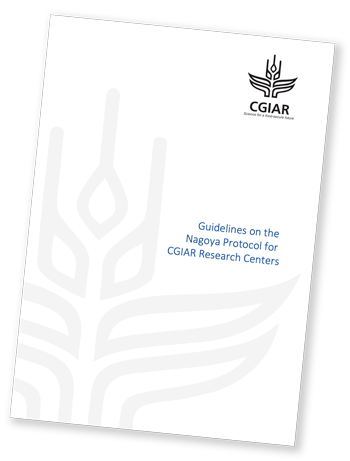The ‘Guidelines on the Nagoya Protocol for CGIAR Research Centers’ have been developed to help genebanks understand the legal requirements of moving plant genetic resources around the world.
Michael Major, Crop Trust
The movement of plant genetic resources between countries is governed by a veritable alphabet soup of treaties and agreements: ITPGRFA, CBD and SMTA for a start. But some agreements are such a mouthful that they’ve proved impossible to condense into acronyms. So, the Nagoya Protocol on Access to Genetic Resources and the Fair and Equitable Sharing of Benefits Arising from their Utilization to the Convention on Biological Diversity is, simply, the CBD’s Nagoya Protocol.
“Sometimes CGIAR staff struggle with understanding the legal requirements of moving plant genetic resources around,” said Michael Halewood, the head of the Policy Unit at Bioversity International and leader of the Genebank Platform Policy Module. “The Nagoya Protocol is the new kid on the block in terms of agreements and is particularly perplexing.” In an attempt to help the CGIAR system get to know this baffling newcomer, the Genebank Platform Policy Module has prepared the Guidelines on the Nagoya Protocol for CGIAR Research Centers (the Guidelines).
Operable systems
The Nagoya Protocol came into force in October 2014 as a supplementary agreement to the 1992 Convention on Biological Diversity (CBD). The Protocol seeks to ensure that when genetic resources are used, the benefits of that use are shared fairly and equitably by the parties involved. To date, the Protocol has been ratified by 118 countries.
The Nagoya Protocol puts in place what the Guidelines call “operable systems” to monitor the use of the material and ensure users comply with the relevant access and benefit-sharing legislation in the provider countries. That means systems that can, and do, work. Its provisions aim to create greater legal certainty and transparency for both providers and users of genetic resources.
“The key behind the Nagoya Protocol is that it provides concrete mechanisms for countries providing plant genetic resources to be able to follow up and attempt to bring legal action against those who aren’t complying with mutually agreed terms,” said Isabel López Noriega, a policy specialist and colleague of Halewood at Bioversity International. “This is something that was missing in the CBD – a mechanism for monitoring the use of the genetic resources and for ensuring compliance.”
CGIAR and Nagoya
Most of the activities undertaken by CGIAR Centers related to plant genetic resources are governed by the International Treaty on Plant Genetic Resources for Food and Agriculture (ITPGRFA) and not by the CBD. However, there are situations when Centers do need to comply with regional, national and sub-national mechanisms that implement the Nagoya Protocol.
“At times, a CGIAR Center might need to access plant genetic resources that are not available through the ITPGRFA’s multilateral system,” said Michael. “And as more countries ratify and implement the Nagoya Protocol, an increasing proportion of the genetic resources that CGIAR Centers may want to collect and use could be affected by laws developed under the Protocol.”
For example, let’s say the International Maize and Wheat Improvement Center (CIMMYT) wants to collect maize in Mexico. Mexico has ratified both the CBD and the Nagoya Protocol, but not the ITPGRFA. So CIMMYT would be required to follow the laws and regulations developed in Mexico for regulating the access to genetic resources and related traditional knowledge, which are currently under preparation.
Traditional knowledge too
Unlike any other binding international agreement, the Nagoya Protocol requires its member countries to ensure that users of genetic resources and associated information obtain access to any traditional knowledge associated with those resources with the prior informed consent (PIC) of the indigenous peoples and local communities that hold such knowledge. Based on this, the Guidelines alert CGIAR Centers that more countries will develop legal frameworks requiring PIC from the farmers who share traditional knowledge associated with genetic resources.
Guiding CGIAR Centers
The Guidelines also points out that in the absence of any concrete obligations under national or customary laws, as part of its overall research ethics, CGIAR is committed to operate with respect to internationally accepted principles and standards. The Guidelines thus explains the internal principles and policies of CGIAR with regard to working with indigenous peoples and local communities, as well as international codes of conducts that can help Centers to meet internationally accepted principles and standards in a practical way.
The Guidelines help CGIAR Centers understand which areas of their plant genetic resources activities could be affected by the Nagoya Protocol. They outline the Centers’ options in terms of compliance with their legal obligations. They address situations where countries have national laws in place implementing the Nagoya Protocol as well as situations where the countries concerned have ratified or acceded to the Nagoya Protocol but do not yet have national laws and systems in place to implement it.
“The need for these guidelines will become increasingly more important as additional countries ratify the Nagoya Protocol and as the 11 CGIAR genebanks distribute plant genetic resources outside of the ITPGRFA’s multilateral system,” said Isabel. For example, a CGIAR Center has worked with national R&D partners in Guatemala including indigenous peoples and the national competent authority to get requisite approvals under the Nagoya Protocol for the first time in that country.
Expanding the Guidelines
Recognizing the increasing importance of the Nagoya Protocol, the Genebank Platform’s Policy Module is now to coordinating the development of additional, complementary materials to help CGIAR germplasm users understand the issues raised, and the guidance provided, by the Guidelines. These will include FAQs, role-playing scenarios teasing out tricky issues, and explanatory videos.
The Policy Module also plans to develop templates, and models and standard practices for acquiring prior informed consent on mutually agreed terms when accessing traditional knowledge or genetic resources that fall under the framework of the CBD and the Nagoya Protocol. Finally, Michael and Isabel hope to develop additional sections of the Guidelines to address Centers’ access and distribution of animal, and microbial genetic resources.
